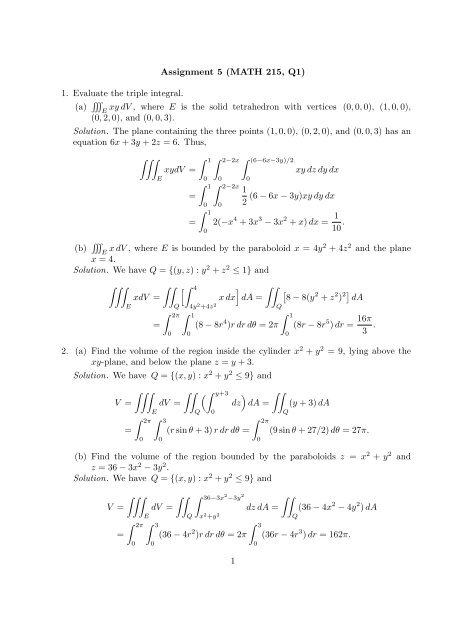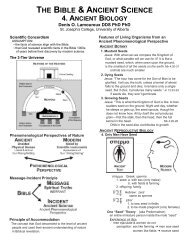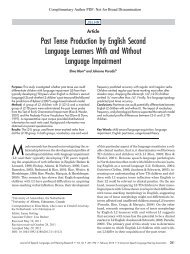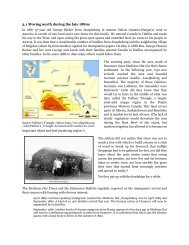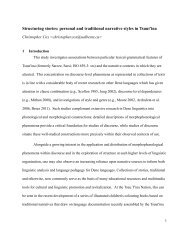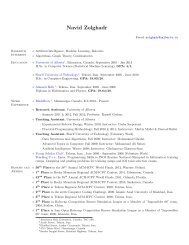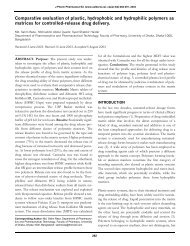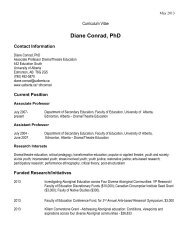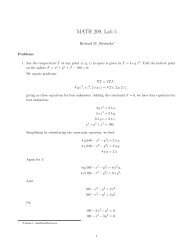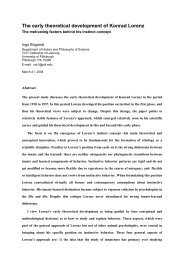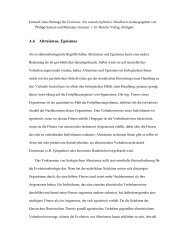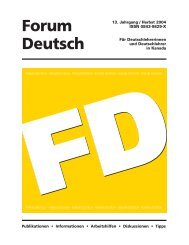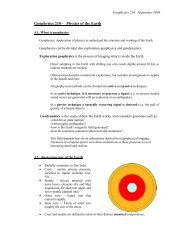Assignment 5 (MATH 215, Q1) 1. Evaluate the triple integral. (a ...
Assignment 5 (MATH 215, Q1) 1. Evaluate the triple integral. (a ...
Assignment 5 (MATH 215, Q1) 1. Evaluate the triple integral. (a ...
Create successful ePaper yourself
Turn your PDF publications into a flip-book with our unique Google optimized e-Paper software.
<strong>Assignment</strong> 5 (<strong>MATH</strong> <strong>215</strong>, <strong>Q1</strong>)<br />
<strong>1.</strong> <strong>Evaluate</strong> <strong>the</strong> <strong>triple</strong> <strong>integral</strong>.<br />
(a) <br />
xy dV , where E is <strong>the</strong> solid tetrahedron with vertices (0, 0, 0), (1, 0, 0),<br />
E<br />
(0, 2, 0), and (0, 0, 3).<br />
Solution. The plane containing <strong>the</strong> three points (1, 0, 0), (0, 2, 0), and (0, 0, 3) has an<br />
equation 6x + 3y + 2z = 6. Thus,<br />
<br />
E<br />
1 2−2x (6−6x−3y)/2<br />
xydV =<br />
xy dz dy dx<br />
0<br />
0<br />
1 2−2x<br />
=<br />
0<br />
1<br />
=<br />
0<br />
0<br />
0<br />
1<br />
(6 − 6x − 3y)xy dy dx<br />
2<br />
2(−x 4 + 3x 3 − 3x 2 + x) dx = 1<br />
10 .<br />
(b) <br />
E x dV , where E is bounded by <strong>the</strong> paraboloid x = 4y2 + 4z2 and <strong>the</strong> plane<br />
x = 4.<br />
Solution. We have Q = {(y, z) : y2 + z2 ≤ 1} and<br />
<br />
E<br />
<br />
xdV =<br />
0<br />
Q<br />
4<br />
0<br />
4y 2 +4z 2<br />
<br />
x dx dA =<br />
Q<br />
8 − 8(y 2 + z 2 ) 2 dA<br />
2π 1<br />
= (8 − 8r 4 1<br />
)r dr dθ = 2π (8r − 8r 5 ) dr = 16π<br />
3 .<br />
2. (a) Find <strong>the</strong> volume of <strong>the</strong> region inside <strong>the</strong> cylinder x 2 + y 2 = 9, lying above <strong>the</strong><br />
xy-plane, and below <strong>the</strong> plane z = y + 3.<br />
Solution. We have Q = {(x, y) : x 2 + y 2 ≤ 9} and<br />
<br />
V =<br />
E<br />
<br />
dV =<br />
Q<br />
y+3<br />
0<br />
<br />
dz dA =<br />
0<br />
Q<br />
(y + 3) dA<br />
2π 3<br />
2π<br />
= (r sin θ + 3) r dr dθ = (9 sin θ + 27/2) dθ = 27π.<br />
0<br />
0<br />
(b) Find <strong>the</strong> volume of <strong>the</strong> region bounded by <strong>the</strong> paraboloids z = x 2 + y 2 and<br />
z = 36 − 3x 2 − 3y 2 .<br />
Solution. We have Q = {(x, y) : x 2 + y 2 ≤ 9} and<br />
<br />
V =<br />
E<br />
<br />
dV =<br />
Q<br />
36−3x 2 −3y 2<br />
x 2 +y 2<br />
0<br />
<br />
dz dA =<br />
Q<br />
(36 − 4x 2 − 4y 2 ) dA<br />
2π 3<br />
= (36 − 4r 2 3<br />
)r dr dθ = 2π (36r − 4r 3 ) dr = 162π.<br />
0<br />
0<br />
1<br />
0
3. Use cylindrical coordinates in <strong>the</strong> following problems.<br />
(a) <strong>Evaluate</strong> <br />
E<br />
z = 9 − x2 − y2 and <strong>the</strong> xy-plane.<br />
x 2 + y 2 dV , where E is <strong>the</strong> solid bounded by <strong>the</strong> paraboloid<br />
Solution. In cylindrical coordinates <strong>the</strong> region E is described by<br />
Thus,<br />
<br />
E<br />
x 2 + y 2 dV =<br />
(b) <strong>Evaluate</strong> <strong>the</strong> <strong>integral</strong> <br />
0 ≤ r ≤ 3, 0 ≤ θ ≤ 2π, and 0 ≤ z ≤ 9 − r 2 .<br />
2π 3 2<br />
9−r 2π 3<br />
r · r dz dr dθ = r 2 (9 − r 2 ) dr dθ<br />
0<br />
0<br />
0<br />
0<br />
0<br />
2π 3<br />
= dθ (9r 2 − r 4 ) dθ = 324π<br />
5 .<br />
E x2 dV , where E is <strong>the</strong> solid that lies within <strong>the</strong> cylinder<br />
x 2 + y 2 = 1, above <strong>the</strong> plane z = 0, and below <strong>the</strong> cone z 2 = 4x 2 + 4y 2 .<br />
Solution. In cylindrical coordinates <strong>the</strong> region E is described by<br />
Thus,<br />
<br />
0 ≤ r ≤ 1, 0 ≤ θ ≤ 2π, and 0 ≤ z ≤ 2r.<br />
E<br />
x 2 2π 1 2r<br />
dV =<br />
(r cos θ) 2 r dz dr dθ<br />
0<br />
0<br />
2π<br />
= cos 2 1<br />
θ dθ<br />
0<br />
0<br />
0<br />
0<br />
0<br />
2r 4 dr = 2π<br />
5 .<br />
4. Use spherical coordinates in <strong>the</strong> following problems.<br />
(a) <strong>Evaluate</strong> <br />
dV , where E is <strong>the</strong> solid that lies between <strong>the</strong> spheres<br />
E x e(x2 +y 2 +z 2 ) 2<br />
x 2 + y 2 + z 2 = 1 and x 2 + y 2 + z 2 = 4 in <strong>the</strong> first octant<br />
{(x, y, z) : x ≥ 0, y ≥ 0, z ≥ 0}.<br />
Solution. In spherical coordinates <strong>the</strong> region E is described by<br />
Thus,<br />
<br />
E<br />
x e (x2 +y 2 +z 2 ) 2<br />
1 ≤ ρ ≤ 2, 0 ≤ θ ≤ π/2, 0 ≤ φ ≤ π/2.<br />
π/2 π/2 2<br />
dV =<br />
(ρ sin φ cos θ) e ρ4<br />
ρ 2 sin φ dρ dθ dφ<br />
0<br />
0<br />
π/2<br />
= sin 2 π/2<br />
φ dφ<br />
0<br />
= π<br />
16 (e16 − e).<br />
2<br />
1<br />
0<br />
2<br />
cos θ dθ ρ<br />
1<br />
3 e ρ4<br />
dρ
(b) <strong>Evaluate</strong><br />
3<br />
−3<br />
√ 9−x 2<br />
− √ 9−x 2<br />
Solution. The <strong>integral</strong> is equal to <br />
√ 9−x 2 −y 2<br />
0<br />
z x 2 + y 2 + z 2 dz dy dx.<br />
E z x 2 + y 2 + z 2 dV , where<br />
E = {(ρ, θ, φ) : 0 ≤ ρ ≤ 3, 0 ≤ θ ≤ 2π, 0 ≤ φ ≤ π/2}.<br />
Therefore, <strong>the</strong> <strong>integral</strong> is equal to<br />
π/2 2π 3<br />
(ρ cos φ) ρ · ρ 2 sin φ dρ dθ dφ<br />
0<br />
0<br />
0<br />
π/2<br />
2π<br />
= cos φ sin φ dφ<br />
0<br />
0<br />
3<br />
dθ ρ<br />
0<br />
4 dρ = 243π<br />
5 .<br />
5. (a) Find <strong>the</strong> center of mass of <strong>the</strong> solid S bounded by <strong>the</strong> paraboloid z = 4x 2 + 4y 2<br />
and <strong>the</strong> plane z = 1 if S has constant density K.<br />
Solution. In cylindrical coordinates <strong>the</strong> region E is described by<br />
Thus, <strong>the</strong> mass of <strong>the</strong> solid is<br />
<br />
M =<br />
The moment about <strong>the</strong> xy-plane is<br />
<br />
Mxy =<br />
0 ≤ r ≤ 1/2, 0 ≤ θ ≤ 2π, and 4r 2 ≤ z ≤ 1<br />
E<br />
E<br />
2π 1/2 1<br />
K dV =<br />
0<br />
0<br />
4r 2<br />
2π 1/2 1<br />
zK dV =<br />
0<br />
0<br />
4r 2<br />
Kr dz dr dθ = Kπ<br />
8 .<br />
Kz r dz dr dθ = Kπ<br />
12 .<br />
Similarly, <strong>the</strong> o<strong>the</strong>r two moments are Mxz = Myz = 0. We have Mxy/M = 2/3.<br />
Hence, <strong>the</strong> center of mass is (0, 0, 2/3).<br />
(b) Find <strong>the</strong> mass of a ball given by x 2 + y 2 + z 2 ≤ a 2 if <strong>the</strong> density at any point is<br />
proportional to its distance from <strong>the</strong> z-axis.<br />
Solution. In spherical coordinates <strong>the</strong> region E is described by<br />
0 ≤ ρ ≤ a, 0 ≤ θ ≤ 2π, 0 ≤ φ ≤ π.<br />
The density is kρ sin φ, where k is a constant. Hence, <strong>the</strong> mass is<br />
<br />
M =<br />
E<br />
2π π a<br />
kρ sin φ dV =<br />
0<br />
0<br />
3<br />
0<br />
(kρ sin φ)ρ 2 sin φ dρ dφ dθ = kπ2 a 4<br />
4<br />
.


